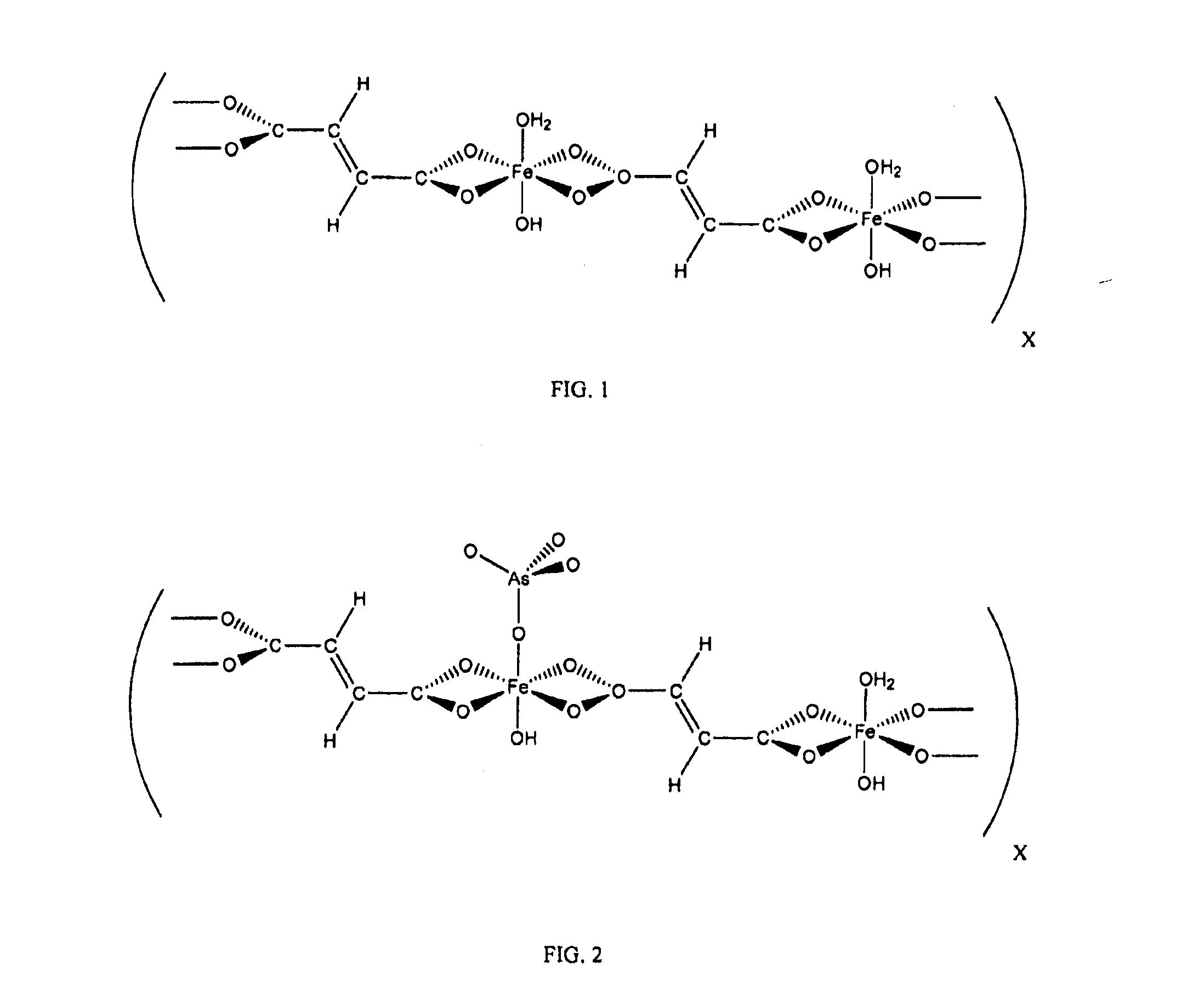Iron coordination polymers for adsorption of arsenate and phosphate
- Summary
- Abstract
- Description
- Claims
- Application Information
AI Technical Summary
Benefits of technology
Problems solved by technology
Method used
Image
Examples
example 1
[0022]In one example, iron fumarate (Product 1) was prepared by adding 300 mL of de-ionized water to 30.02 mmol of fumaric acid and 57.98 mmol of sodium hydroxide. Another aqueous solution was prepared using 300 mL of de-ionized water and 14.93 mmol of iron (III) chloride hexahydrate (a molar ratio of 1:2:4 iron (III) chloride: fumaric acid: sodium hydroxide). The first solution was added to the second, resulting in immediate precipitate formation. The resulting mixture was stirred for 30 hours using a magnetic stirrer. The product was obtained by vacuum filtration and washed with copious amounts of de-ionized water. It was then allowed to dry under vacuum, yielding 3.156 g (9.93 mmol, 66.5%) of amorphous iron basic carboxylate powder. Within the present disclosure, the term amorphous refers to a substance that does not have any appreciable repeating crystalline structure. Thermogravimetric analysis was carried out on Product 1, which indicated a molecular formula of Fe2(C4H2O4)4(OH...
example 2
[0024]In another example, iron fumarate (Product 2) was prepared by adding 300 mL de-ionized water to 30.03 mmol of fumaric acid and 90.46 mmol of sodium hydroxide. Another aqueous solution was prepared by adding 300 mL de-ionized water to 30.03 mmol of iron (III) chloride hexahydrate (a molar ratio of 1:1:3 iron (III) chloride: fumaric acid: sodium hydroxide). The first solution was added to the second, resulting in immediate precipitate formation. The resulting mixture was stirred for about 7 days using a magnetic stirrer. The product was obtained by vacuum filtration and washed with de-ionized water. It was then allowed to dry under vacuum, yielding 5.776 g of product.
[0025]Phosphate adsorption experiments were again performed for Product 2. Phosphate solutions of increasing concentrations were prepared and added to 0.05 grams of iron fumarate prepared as stated. The volume of phosphate solution added was kept constant at 15 mL. After two days, the phosphate concentration was mea...
example 3
[0026]In another example, iron fumarate (Product 3) was prepared by adding 0.09 mmol (3.6 g) sodium hydroxide to 300 mL de-ionized water in a 500 mL Erlenmeyer flask. To this solution was added 0.03 mmol (3.482 g) fumaric acid, which was stirred to dissolution. In a 1 L Erlenmeyer flask 0.03 mmol (8.109 g) of iron chloride hexahydrate was stirred to dissolution in 300 ml of de-ionized water. While stirring slowly, the sodium hydroxide / fumaric acid solution was added to the iron chloride solution. The resulting precipitate was collected by vacuum filtration with a fine porosity glass frit. The collected precipitate was washed with de-ionized water until no chloride was detected (via formation of silver chloride). The precipitate was then dried at room temperature under vacuum producing the final product.
[0027]The surface area of the iron fumarate of Product 3 was measured using a Quantachrome Nova 1200 by the 6 point BET method. The specific surface area was determined to be 18.80 m2...
PUM
| Property | Measurement | Unit |
|---|---|---|
| Time | aaaaa | aaaaa |
Abstract
Description
Claims
Application Information
 Login to View More
Login to View More - R&D
- Intellectual Property
- Life Sciences
- Materials
- Tech Scout
- Unparalleled Data Quality
- Higher Quality Content
- 60% Fewer Hallucinations
Browse by: Latest US Patents, China's latest patents, Technical Efficacy Thesaurus, Application Domain, Technology Topic, Popular Technical Reports.
© 2025 PatSnap. All rights reserved.Legal|Privacy policy|Modern Slavery Act Transparency Statement|Sitemap|About US| Contact US: help@patsnap.com



